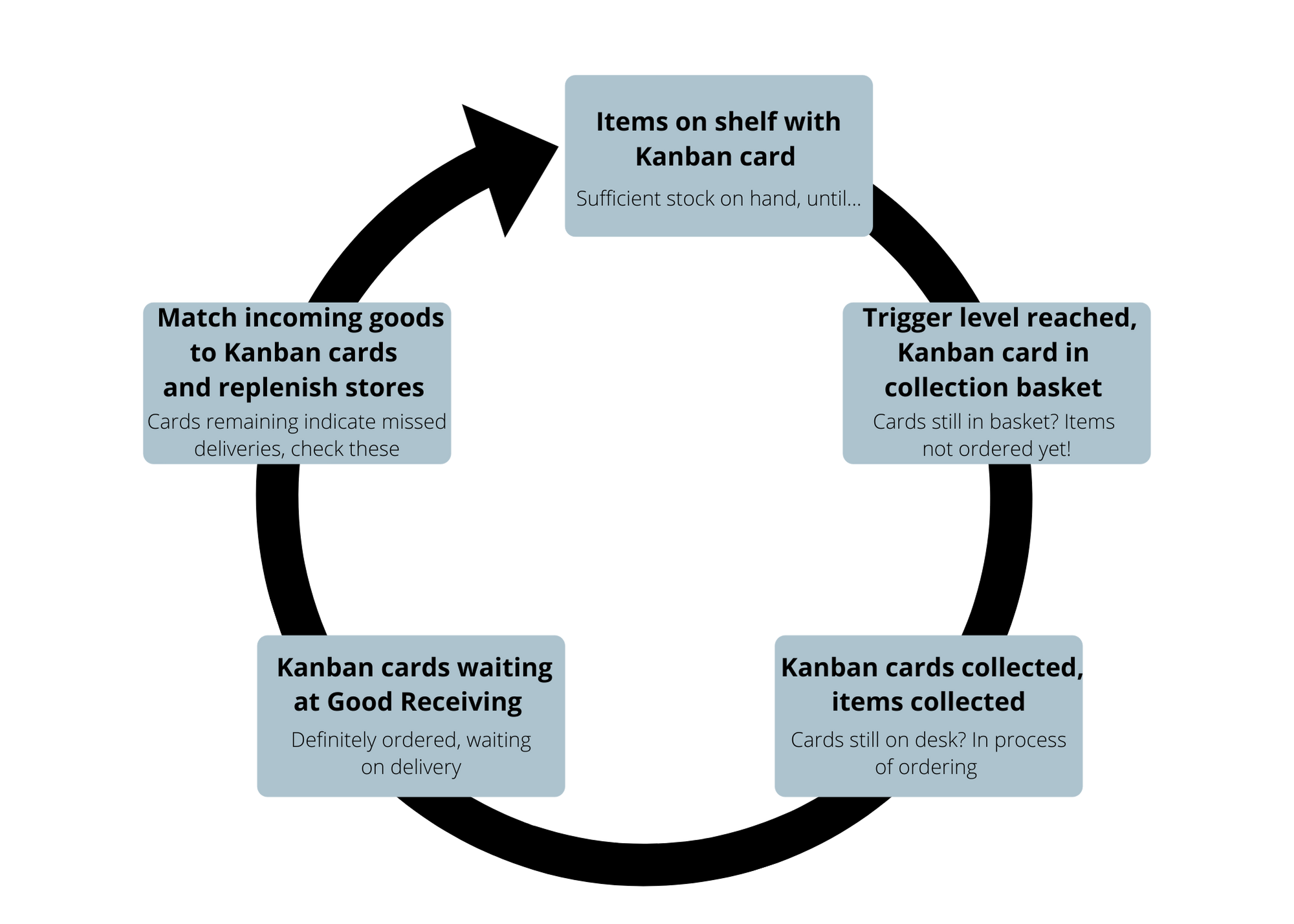The three manufacturing inefficiency culprits discussed today are:
- Consumables replenishment,
- Hitting targets, and
- Disjointed value streams.
Stock Replenishment
Let’s start with something simple – running out of those small consumables needed to do the work. Most manufacturing sites are good at managing procurement for large items or major projects, but at the same time they continue to experience frustration as they run out of gloves, spray paint, bolts, and other small items. These small items often cause major productivity losses.
“Why did you wait until we were nearly out to tell me?!” Every manager has heard themselves asking this question in exasperation. No matter how many times the issues has been addressed, running out of consumables continues to happen. It almost seems as if it’s a deliberate way to get out of work.
Let me offer another explanation – most people are trying to do the right thing. It’s not that they deliberately wait until stocks are low, but instead it’s a combination of unclear guidelines (how low is low enough?) and hurrying back to complete the job at hand with the intention of telling the boss a bit later, but then forgetting. Oh, and don’t forget that you just yelled at the person who did actually come to tell you. Perhaps they may leave that task to someone else, next time!
Manufacturers have tried many things to address this, but each have major drawbacks:
- Regular stocktakes are time consuming and expensive,
- A “shopping list” whiteboard still doesn’t get filled out, and
- A storeman with a locked-up storeroom is not only expensive, but also increases the time taken to retrieve supplies, and still doesn’t work!
Let me introduce a Lean manufacturing solution – 5S Housekeeping and Organisation paired with Kanban signals. First, 5S Housekeeping and Organisation. Make it clear what the reorder trigger point is! Mark this and make a clear visual indicator where the item is stored. This example for paper rolls from Brady’s 50 Lean Visuals handbook is a good example:
Now, there’s no judgement required from every individual employee who takes a roll off the stack. There’s no need for everyone to know details of the supplier lead time, minimum order quantity, end of month ordering, or anything else – all that information has already been considered and is encoded in the reorder point of 2 rolls.
You can do the same thing for your gloves, spray paint, bolts – whatever items you have in your store. Make sure the reorder point (also called reorder trigger level) allows enough time to complete reorder, delivery, and replenishment.
Next, make it absolutely simple for anyone to trigger the correct re-ordering process. Do this by implementing a Kanban replenishment system. Make a Kanban card that has all the information needed to reorder the part – part number, part name, supplier, order quantity, part location and reorder trigger level. (The part location and reorder trigger level will be needed when replenishing the container with the newly arrived parts.) An example is shown below:
Place these cards so that as the reorder point or trigger level is reached, the card must be removed to access the parts. For the paper rolls as shown above, this may be as simple as sliding the card between the rolls. For small parts, often a plastic bag or small container is used to hold the remaining stock and also the Kanban card. Do whatever works for your company.
Then, place a collection basket at a convenient place, everywhere Kanban cards are used. This might be at the exit to the storeroom, at the end of each aisle, or in several locations within your company. A cheap basket like this one from Officeworks is ideal, and can be mounted to poles using the holes in the sides, or drilled through the bottom.
This means that when the trigger level is reached, the person using the next item has the Kanban card in one hand, the item in the other, AND has a convenient place to put the Kanban card. For them, that’s it – item reorder complete!
For the purchasing officer who has to order the items from the supplier, no longer do they get interrupted at many random times with one item each time. When it’s convenient for them, they make a routine trip around all the Kanban collection baskets, gather all the cards, and reorder the items on those cards. The cards are then placed at the incoming goods area, and matched to items as they arrived.
Goods Receiving pairs the Kanban cards to the incoming goods, and the cycle is complete. Kanban cards left over at Goods Receiving indicate a missed or delayed delivery, which may need to be checked.
Here’s an example of the complete cycle, along with a guide to how the system supports visual cross-checking:

Implementing a Kanban stock replenishment system can address this manufacturing inefficiency culprit and fix the problem of stock replenishment permanently.
Hitting targets, meeting benchmarks
Yes, hitting targets can cause manufacturing inefficiencies. How so? Well, because the world doesn’t stand still. As a good manager, you’re paying attention to product development and also to the acquisition of new equipment, in order to build or maintain a competitive edge. You’re also judged on your ability to manufacture product within budget.
However, your competitors are also improving their products and their equipment, and a new competitor may be just around the corner. If you are improving your processes as well as your products and equipment, then you will have an advantage. If not, then your competitor will have the advantage!
So, you must also find improvements in your processes, but where to look? How should you determine which processes have the biggest opportunities for improvement… the ones that are missing their targets, right? Not necessarily! Adjust everyone’s targets by 10%? Absolutely not!
How were the targets determined? In most companies, they are based on historical performance. In some companies, a good operator and experienced estimator combine to deliver higher confidence in the target or benchmark.
However, these targets are nearly always based on the way tasks have traditionally been performed. Why is the task performed that way? Often, it’s because the first time we had to do that task someone figured out a reasonable method, they became the expert, and that’s the way it’s done from now on! A trade qualified operator should be able to arrive at a method that is safe, effective, and efficient – hopefully the first person to perform the task at your company was a good tradesperson. In nearly all cases, the standard time is reasonable, defensible, and provides nearly zero guidance on how much improvement is possible.
After all, that’s what we really want to know – where is the biggest opportunity for improvement? Whether your people are meeting or missing the targets is mostly a result of whether we estimated correctly, based on the chosen method of the person performing the task.
Instead, ask yourself the most important Lean question: “What does the customer actually value in this process?” That is, which parts of the process are changing the product to deliver a benefit to the customer? By doing this, you will identify the processes with the largest opportunity for improvement – by eliminating tasks – whether those processes are meeting their target or not.
As you can see, hitting targets and meeting benchmarks can cause manufacturing inefficiencies by preventing you from looking deeper at your processes, in search of improvement. Identifying the largest opportunities for improvement is the road to significant improvements in manufacturing efficiency.
Disjointed Value Streams
Lastly, disjointed value streams are one of the largest manufacturing inefficiency culprits.
We are quite experienced at managing people, and at managing production processes, but the concept of managing a value stream is a foreign concept to most people outside Lean thinkers.
A value stream is the sequence of all actions required to deliver a product or service to a market. Inside a company, this can include everything from taking an order and ordering raw materials to delivering the product to the customer – and everything in between,
Because we are so experienced at managing people, and at managing production processes, we are usually able to ensure people and equipment have very little downtime – we make sure they always have something to do.
Unfortunately, much of the time people and processes are busy working on something that’s not needed now, and will wait a long time before being used. People on one side of the factory are making large amounts of something that won’t be used by people on the other side of the factory for several weeks. This is caused by shared processes, which then need production planning and scheduling for co-ordination, and which also leads to batching because the shared resources are serving multiple downstream processes. Storage, handling, transport, money, space, and management are all required to cope with this early production and allow for batching and production that is scheduled well in advance.
Lean Thinkers reading this will identify the Lean Wastes caused by this Overproduction, but to everyone else it looks like a normal part of running a normal manufacturing company that doesn’t have the luxury of producing the same things, day after day.
Because we have come to accept this as normal, we have accepted the level of manufacturing inefficiency that is created by managing many different types of jobs through a common process.
However, even in these real-world factories, there are typically similar types of work. This may be common production sequences, similar customers, or a higher volume part of the product range. These are the most significant value streams in your workshop, and then there’s the long tail of “everything else” which can be hard to classify.
Fixing disjointed value streams challenges us to consider organising a factory around the most significant value streams. Instead of shared resources, organised by function, is it possible to align machinery, people, and processes along value-stream lines so that they are “dedicated” to serving a particular value stream?
This would allow us to greatly reduce the coordination effort required, since each person is (usually) accepting product from the same upstream process, and delivering it to the same downstream process. This usually is in parentheses because naturally there will always be unusual conditions where special arrangements need to be made. However, value stream thinking can make this the exception, rather than the rule!
Because processes are more closely linked, they can be managed more easily, communicated more effectively, reduce work in progress, reduce lead time, and begin to optimise themselves to suit the needs of their normal downstream customer – increasing manufacturing efficiency and attacking inefficiency culprits.
Summary
In this article I have introduced three manufacturing inefficiency culprits and how to fix them:
- Stock Replenishment, addressed with 5S Housekeeping and Organisation and Kanban system,
- Hitting targets and meeting benchmarks, tackled by asking the important Lean question “What does the customer actually value in this process?” and then seeking to eliminate any task or activity that doesn’t add value to the customer, and finally
- Disjointed value streams, best addressed by changing to value stream thinking, leading to a reorganisation of processes and management, improving manufacturing efficiency.

